Parking assist VOLKSWAGEN TIGUAN 2017 Owner´s Manual
[x] Cancel search | Manufacturer: VOLKSWAGEN, Model Year: 2017, Model line: TIGUAN, Model: VOLKSWAGEN TIGUAN 2017Pages: 341, PDF Size: 9.14 MB
Page 139 of 341
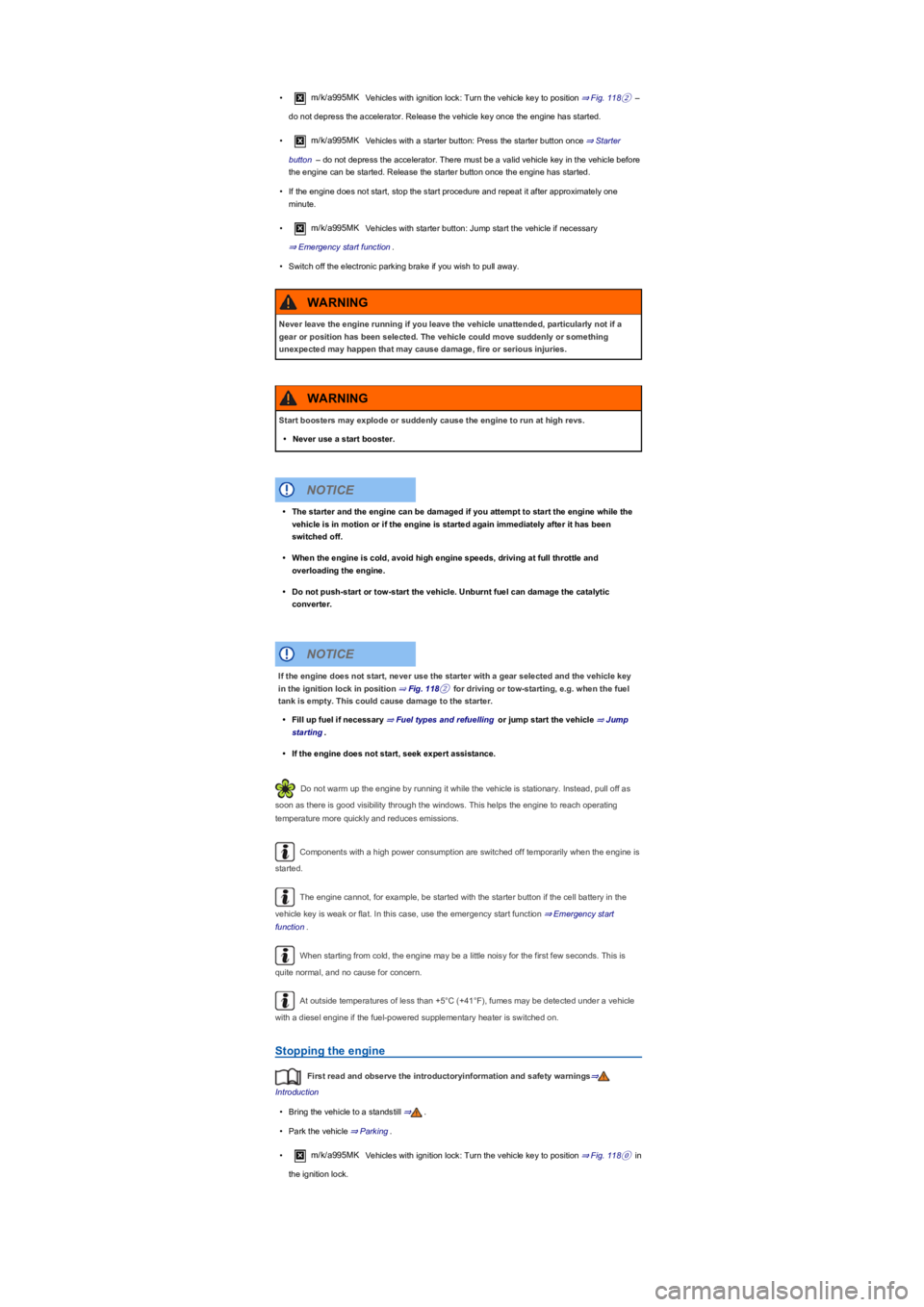
•m/k/a995MKVehicles with ignition lock: Turn the vehicle key to position ⇒ Fig. 118② –
do not depress the accelerator. Release the vehicle key once the engine has started.
•m/k/a995MKVehicles with a starter button: Press the starter button once ⇒ Starter
button – do not depress the accelerator. There must be a valid vehicle key in the vehicle before
the engine can be started. Release the starter button once the engine has started.
•If the engine does not start, stop the start procedure and repeat it after approximately one
minute.
•m/k/a995MK Vehicles with starter button: Jump start the vehicle if necessary
⇒ Emergency start function.
•Switch off the electronic parking brake if you wish to pull away.
Do not warm up the engine by running it while the vehicle is stationary. Instead, pull off as
soon as there is good visibility through the windows. This helps the engine to reach operating
temperature more quickly and reduces emissions.
Components with a high power consumption are switched off temporarily when the engine is
started.
The engine cannot, for example, be started with the starter button if the cell battery in the
vehicle key is weak or flat. In this case, use the emergency start function ⇒ Emergency start
function.
When starting from cold, the engine may be a little noisy for the first few seconds. This is
quite normal, and no cause for concern.
At outside temperatures of less than +5°C (+41°F), fumes may be detected under a vehicle
with a diesel engine if the fuel-powered supplementary heater is switched on.
Stopping the engine
First read and observe the introductoryinformation and safety warnings⇒
Introduction
•Bring the vehicle to a standstill ⇒.
•Park the vehicle ⇒ Parking.
•m/k/a995MKVehicles with ignition lock: Turn the vehicle key to position ⇒ Fig. 118⓪ in
the ignition lock.
Never leave the engine running if you leave the vehicle unattended, particularly not if a
gear or position has been selected. The vehicle could move suddenly or something
unexpected may happen that may cause damage, fire or serious injuries.
WARNING
Start boosters may explode or suddenly cause the engine to run at high revs.
•Never use a start booster.
WARNING
•The starter and the engine can be damaged if you attempt to start the engine while the
vehicle is in motion or if the engine is started again immediately after it has been
switched off.
•When the engine is cold, avoid high engine speeds, driving at full throttle and
overloading the engine.
•Do not push-start or tow-start the vehicle. Unburnt fuel can damage the catalytic
converter.
NOTICE
If the engine does not start, never use the starter with a gear selected and the vehicle key
in the ignition lock in position ⇒ Fig. 118② for driving or tow-starting, e.g. when the fuel
tank is empty. This could cause damage to the starter.
•Fill up fuel if necessary ⇒ Fuel types and refuelling or jump start the vehicle ⇒ Jump
starting.
•If the engine does not start, seek expert assistance.
NOTICE
Page 150 of 341
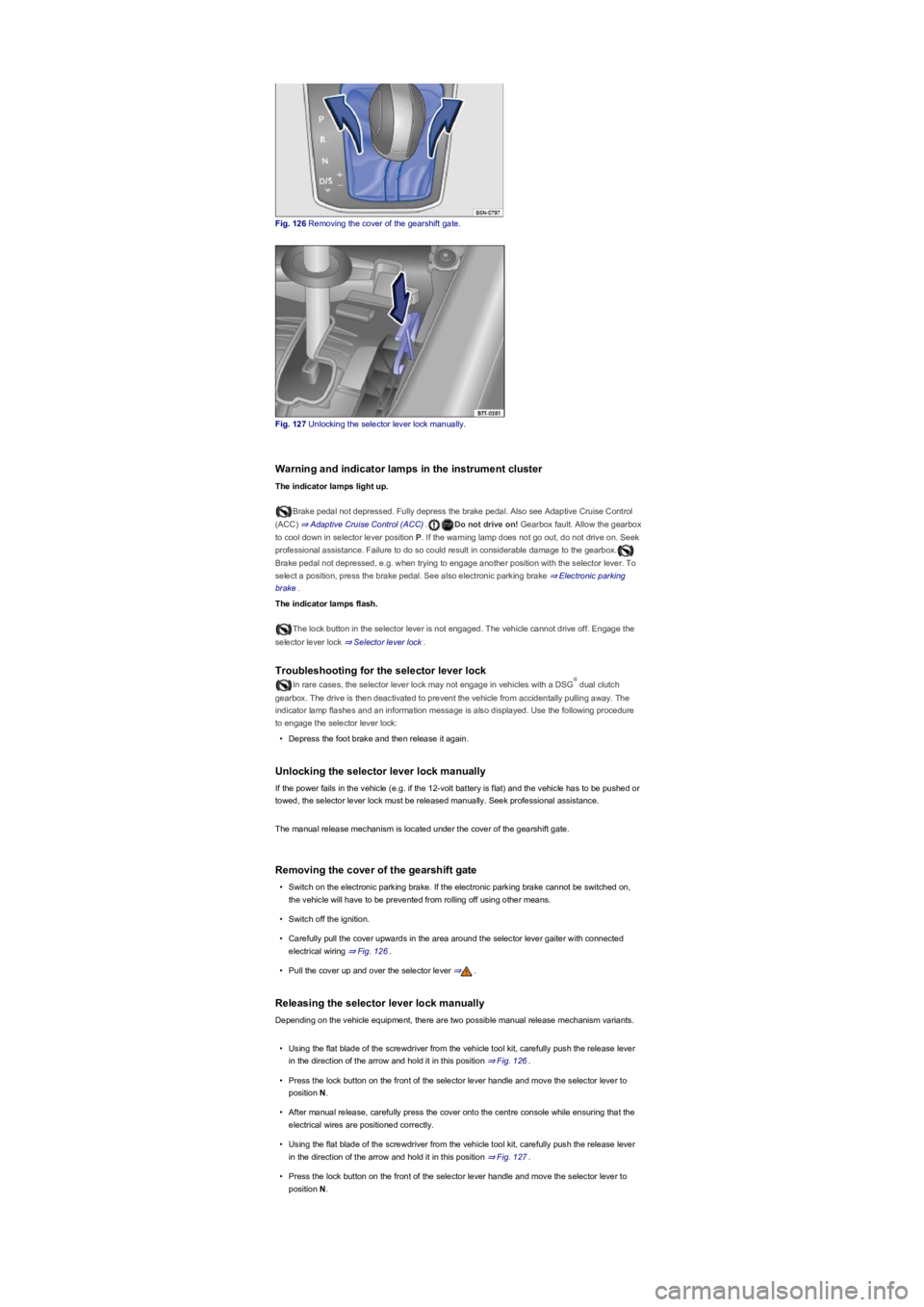
Fig. 126 Removing the cover of the gearshift gate.
Fig. 127 Unlocking the selector lever lock manually.
Warning and indicator lamps in the instrument cluster
The indicator lamps light up.
Brake pedal not depressed. Fully depress the brake pedal. Also see Adaptive Cruise Control
(ACC) ⇒ Adaptive Cruise Control (ACC).Do not drive on! Gearbox fault. Allow the gearbox
to cool down in selector lever position P. If the warning lamp does not go out, do not drive on. Seek
professional assistance. Failure to do so could result in considerable damage to the gearbox.
Brake pedal not depressed, e.g. when trying to engage another position with the selector lever. To
select a position, press the brake pedal. See also electronic parking brake ⇒ Electronic parking
brake.
The indicator lamps flash.
The lock button in the selector lever is not engaged. The vehicle cannot drive off. Engage the
selector lever lock ⇒ Selector lever lock.
Troubleshooting for the selector lever lock
In rare cases, the selector lever lock may not engage in vehicles with a DSG dual clutch
gearbox. The drive is then deactivated to prevent the vehicle from accidentally pulling away. The
indicator lamp flashes and an information message is also displayed. Use the following procedure
to engage the selector lever lock:
•Depress the foot brake and then release it again.
Unlocking the selector lever lock manually
If the power fails in the vehicle (e.g. if the 12-volt battery is flat) and the vehicle has to be pushed or
towed, the selector lever lock must be released manually. Seek professional assistance.
The manual release mechanism is located under the cover of the gearshift gate.
Removing the cover of the gearshift gate
•Switch on the electronic parking brake. If the electronic parking brake cannot be switched on,
the vehicle will have to be prevented from rolling off using other means.
•Switch off the ignition.
•Carefully pull the cover upwards in the area around the selector lever gaiter with connected
electrical wiring ⇒ Fig. 126.
•Pull the cover up and over the selector lever ⇒.
Releasing the selector lever lock manually
Depending on the vehicle equipment, there are two possible manual release mechanism variants.
•Using the flat blade of the screwdriver from the vehicle tool kit, carefully push the release lever
in the direction of the arrow and hold it in this position ⇒ Fig. 126.
•Press the lock button on the front of the selector lever handle and move the selector lever to
position N.
•After manual release, carefully press the cover onto the centre console while ensuring that the
electrical wires are positioned correctly.
•Using the flat blade of the screwdriver from the vehicle tool kit, carefully push the release lever
in the direction of the arrow and hold it in this position ⇒ Fig. 127.
•Press the lock button on the front of the selector lever handle and move the selector lever to
position N.
®
Page 151 of 341
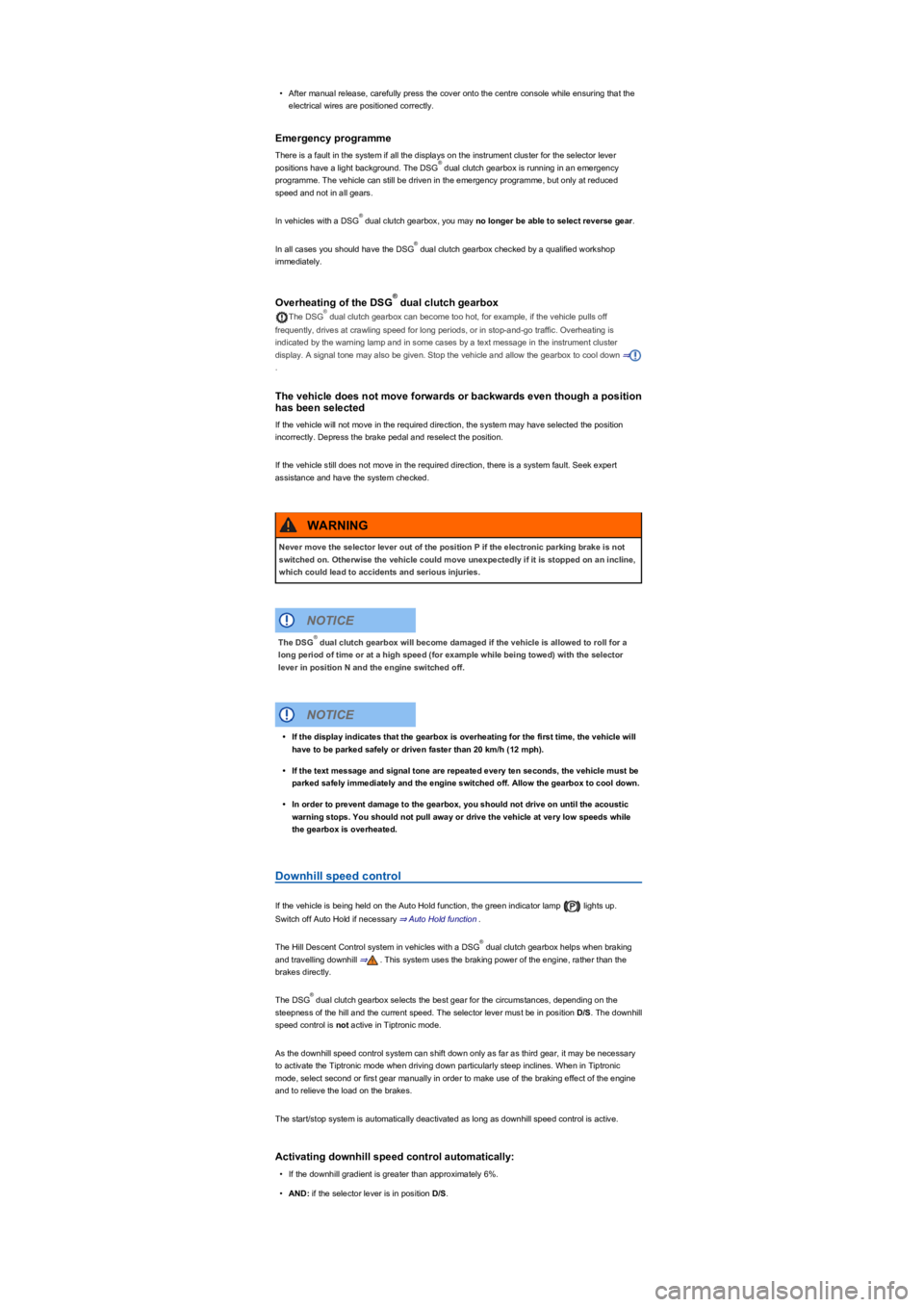
•After manual release, carefully press the cover onto the centre console while ensuring that the
electrical wires are positioned correctly.
Emergency programme
There is a fault in the system if all the displays on the instrument cluster for the selector lever
positions have a light background. The DSG dual clutch gearbox is running in an emergency
programme. The vehicle can still be driven in the emergency programme, but only at reduced
speed and not in all gears.
In vehicles with a DSG dual clutch gearbox, you may no longer be able to select reverse gear.
In all cases you should have the DSG dual clutch gearbox checked by a qualified workshop
immediately.
Overheating of the DSG dual clutch gearbox
The DSG dual clutch gearbox can become too hot, for example, if the vehicle pulls off
frequently, drives at crawling speed for long periods, or in stop-and-go traffic. Overheating is
indicated by the warning lamp and in some cases by a text message in the instrument cluster
display. A signal tone may also be given. Stop the vehicle and allow the gearbox to cool down ⇒
.
The vehicle does not move forwards or backwards even though a position
has been selected
If the vehicle will not move in the required direction, the system may have selected the position
incorrectly. Depress the brake pedal and reselect the position.
If the vehicle still does not move in the required direction, there is a system fault. Seek expert
assistance and have the system checked.
Downhill speed control
If the vehicle is being held on the Auto Hold function, the green indicator lamp lights up.
Switch off Auto Hold if necessary ⇒ Auto Hold function.
The Hill Descent Control system in vehicles with a DSG dual clutch gearbox helps when braking
and travelling downhill ⇒. This system uses the braking power of the engine, rather than the
brakes directly.
The DSG dual clutch gearbox selects the best gear for the circumstances, depending on the
steepness of the hill and the current speed. The selector lever must be in position D/S. The downhill
speed control is not active in Tiptronic mode.
As the downhill speed control system can shift down only as far as third gear, it may be necessary
to activate the Tiptronic mode when driving down particularly steep inclines. When in Tiptronic
mode, select second or first gear manually in order to make use of the braking effect of the engine
and to relieve the load on the brakes.
The start/stop system is automatically deactivated as long as downhill speed control is active.
Activating downhill speed control automatically:
•If the downhill gradient is greater than approximately 6%.
•AND: if the selector lever is in position D/S.
®
®
®
®
®
Never move the selector lever out of the position P if the electronic parking brake is not
switched on. Otherwise the vehicle could move unexpectedly if it is stopped on an incline,
which could lead to accidents and serious injuries.
WARNING
The DSG dual clutch gearbox will become damaged if the vehicle is allowed to roll for a
long period of time or at a high speed (for example while being towed) with the selector
lever in position N and the engine switched off.
NOTICE
®
•If the display indicates that the gearbox is overheating for the first time, the vehicle will
have to be parked safely or driven faster than 20 km/h (12 mph).
•If the text message and signal tone are repeated every ten seconds, the vehicle must be
parked safely immediately and the engine switched off. Allow the gearbox to cool down.
•In order to prevent damage to the gearbox, you should not drive on until the acoustic
warning stops. You should not pull away or drive the vehicle at very low speeds while
the gearbox is overheated.
NOTICE
®
®
Page 154 of 341
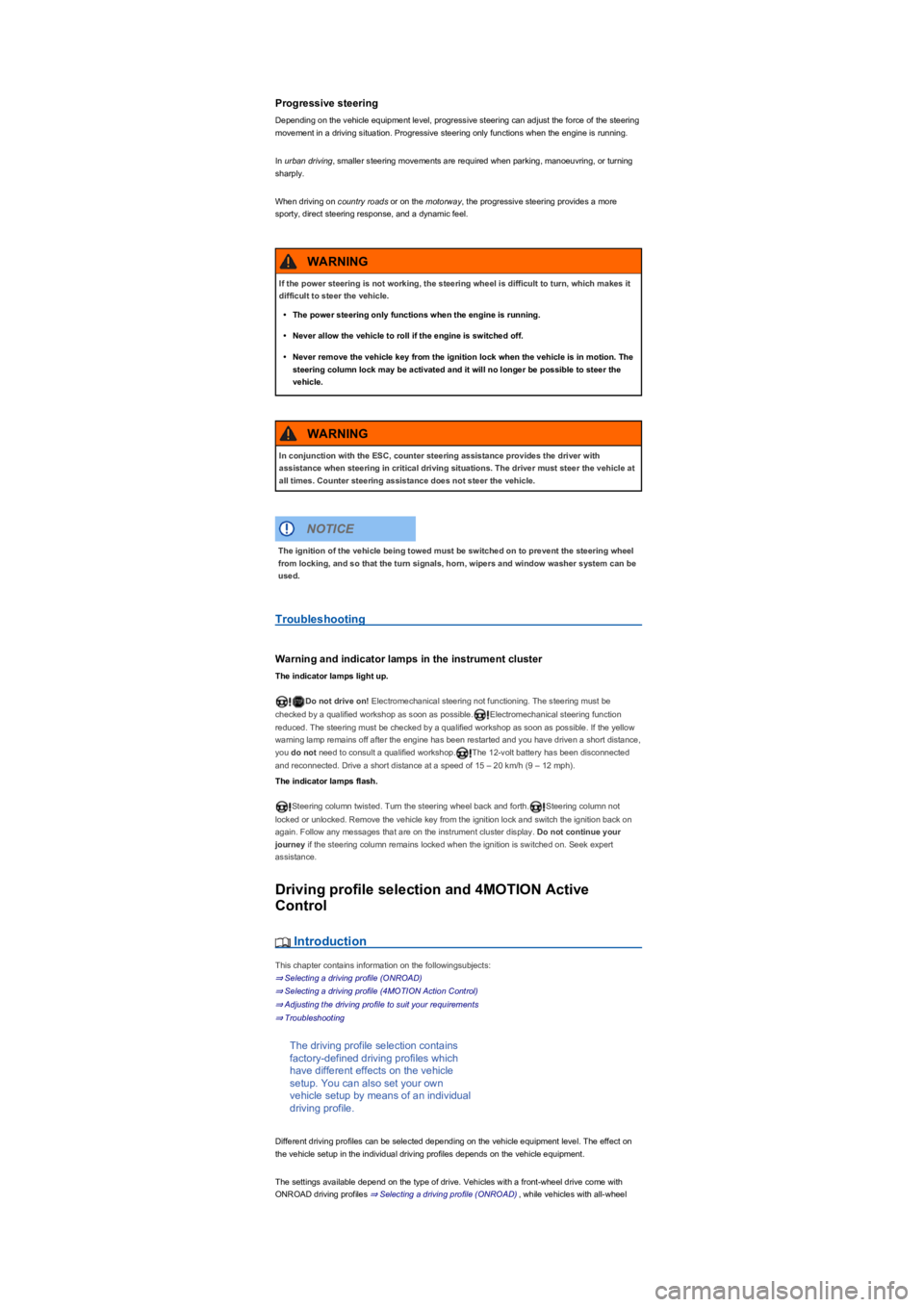
Progressive steering
Depending on the vehicle equipment level, progressive steering can adjust the force of the steering
movement in a driving situation. Progressive steering only functions when the engine is running.
In urban driving, smaller steering movements are required when parking, manoeuvring, or turning
sharply.
When driving on country roads or on the motorway, the progressive steering provides a more
sporty, direct steering response, and a dynamic feel.
Troubleshooting
Warning and indicator lamps in the instrument cluster
The indicator lamps light up.
Do not drive on! Electromechanical steering not functioning. The steering must be
checked by a qualified workshop as soon as possible.Electromechanical steering function
reduced. The steering must be checked by a qualified workshop as soon as possible. If the yellow
warning lamp remains off after the engine has been restarted and you have driven a short distance,
you do not need to consult a qualified workshop.The 12-volt battery has been disconnected
and reconnected. Drive a short distance at a speed of 15 – 20 km/h (9 – 12 mph).
The indicator lamps flash.
Steering column twisted. Turn the steering wheel back and forth.Steering column not
locked or unlocked. Remove the vehicle key from the ignition lock and switch the ignition back on
again. Follow any messages that are on the instrument cluster display. Do not continue your
journey if the steering column remains locked when the ignition is switched on. Seek expert
assistance.
Driving profile selection and 4MOTION Active
Control
Introduction
This chapter contains information on the followingsubjects:
⇒ Selecting a driving profile (ONROAD)
⇒ Selecting a driving profile (4MOTION Action Control)
⇒ Adjusting the driving profile to suit your requirements
⇒ Troubleshooting
The driving profile selection contains
factory-defined driving profiles which
have different effects on the vehicle
setup. You can also set your own
vehicle setup by means of an individual
driving profile.
Different driving profiles can be selected depending on the vehicle equipment level. The effect on
the vehicle setup in the individual driving profiles depends on the vehicle equipment.
The settings available depend on the type of drive. Vehicles with a front-wheel drive come with
ONROAD driving profiles ⇒ Selecting a driving profile (ONROAD), while vehicles with all-wheel
If the power steering is not working, the steering wheel is difficult to turn, which makes it
difficult to steer the vehicle.
•The power steering only functions when the engine is running.
•Never allow the vehicle to roll if the engine is switched off.
•Never remove the vehicle key from the ignition lock when the vehicle is in motion. The
steering column lock may be activated and it will no longer be possible to steer the
vehicle.
WARNING
In conjunction with the ESC, counter steering assistance provides the driver with
assistance when steering in critical driving situations. The driver must steer the vehicle at
all times. Counter steering assistance does not steer the vehicle.
WARNING
The ignition of the vehicle being towed must be switched on to prevent the steering wheel
from locking, and so that the turn signals, horn, wipers and window washer system can be
used.
NOTICE
Page 186 of 341
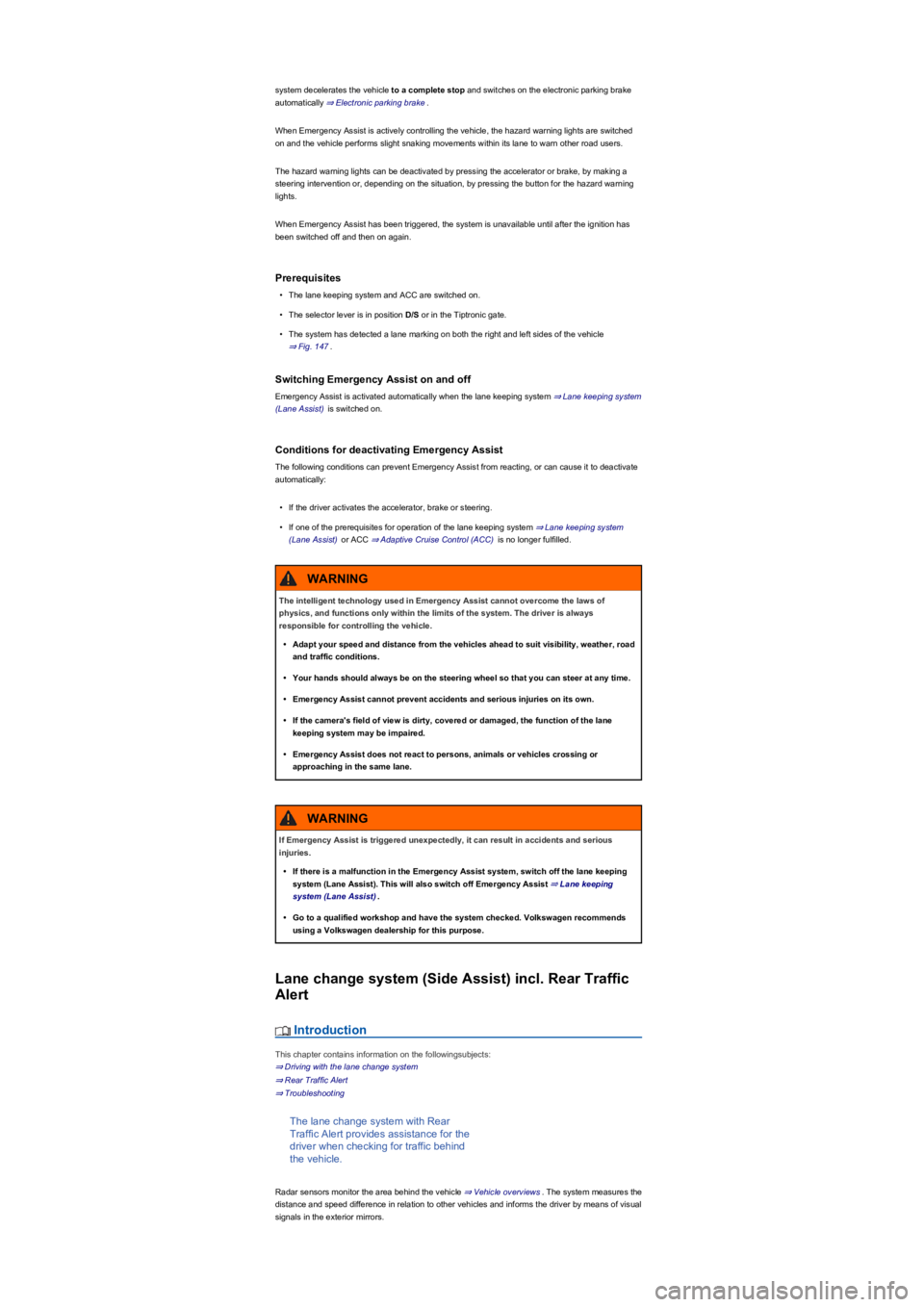
system decelerates the vehicle to a complete stop and switches on the electronic parking brake
automatically ⇒ Electronic parking brake.
When Emergency Assist is actively controlling the vehicle, the hazard warning lights are switched
on and the vehicle performs slight snaking movements within its lane to warn other road users.
The hazard warning lights can be deactivated by pressing the accelerator or brake, by making a
steering intervention or, depending on the situation, by pressing the button for the hazard warning
lights.
When Emergency Assist has been triggered, the system is unavailable until after the ignition has
been switched off and then on again.
Prerequisites
•The lane keeping system and ACC are switched on.
•The selector lever is in position D/S or in the Tiptronic gate.
•The system has detected a lane marking on both the right and left sides of the vehicle
⇒ Fig. 147.
Switching Emergency Assist on and off
Emergency Assist is activated automatically when the lane keeping system ⇒ Lane keeping system
(Lane Assist) is switched on.
Conditions for deactivating Emergency Assist
The following conditions can prevent Emergency Assist from reacting, or can cause it to deactivate
automatically:
•If the driver activates the accelerator, brake or steering.
•If one of the prerequisites for operation of the lane keeping system ⇒ Lane keeping system
(Lane Assist) or ACC ⇒ Adaptive Cruise Control (ACC) is no longer fulfilled.
Lane change system (Side Assist) incl. Rear Traffic
Alert
Introduction
This chapter contains information on the followingsubjects:
⇒ Driving with the lane change system
⇒ Rear Traffic Alert
⇒ Troubleshooting
The lane change system with Rear
Traffic Alert provides assistance for the
driver when checking for traffic behind
the vehicle.
Radar sensors monitor the area behind the vehicle ⇒ Vehicle overviews. The system measures the
distance and speed difference in relation to other vehicles and informs the driver by means of visual
signals in the exterior mirrors.
The intelligent technology used in Emergency Assist cannot overcome the laws of
physics, and functions only within the limits of the system. The driver is always
responsible for controlling the vehicle.
•Adapt your speed and distance from the vehicles ahead to suit visibility, weather, road
and traffic conditions.
•Your hands should always be on the steering wheel so that you can steer at any time.
•Emergency Assist cannot prevent accidents and serious injuries on its own.
•If the camera's field of view is dirty, covered or damaged, the function of the lane
keeping system may be impaired.
•Emergency Assist does not react to persons, animals or vehicles crossing or
approaching in the same lane.
WARNING
If Emergency Assist is triggered unexpectedly, it can result in accidents and serious
injuries.
•If there is a malfunction in the Emergency Assist system, switch off the lane keeping
system (Lane Assist). This will also switch off Emergency Assist ⇒ Lane keeping
system (Lane Assist).
•Go to a qualified workshop and have the system checked. Volkswagen recommends
using a Volkswagen dealership for this purpose.
WARNING
Page 187 of 341
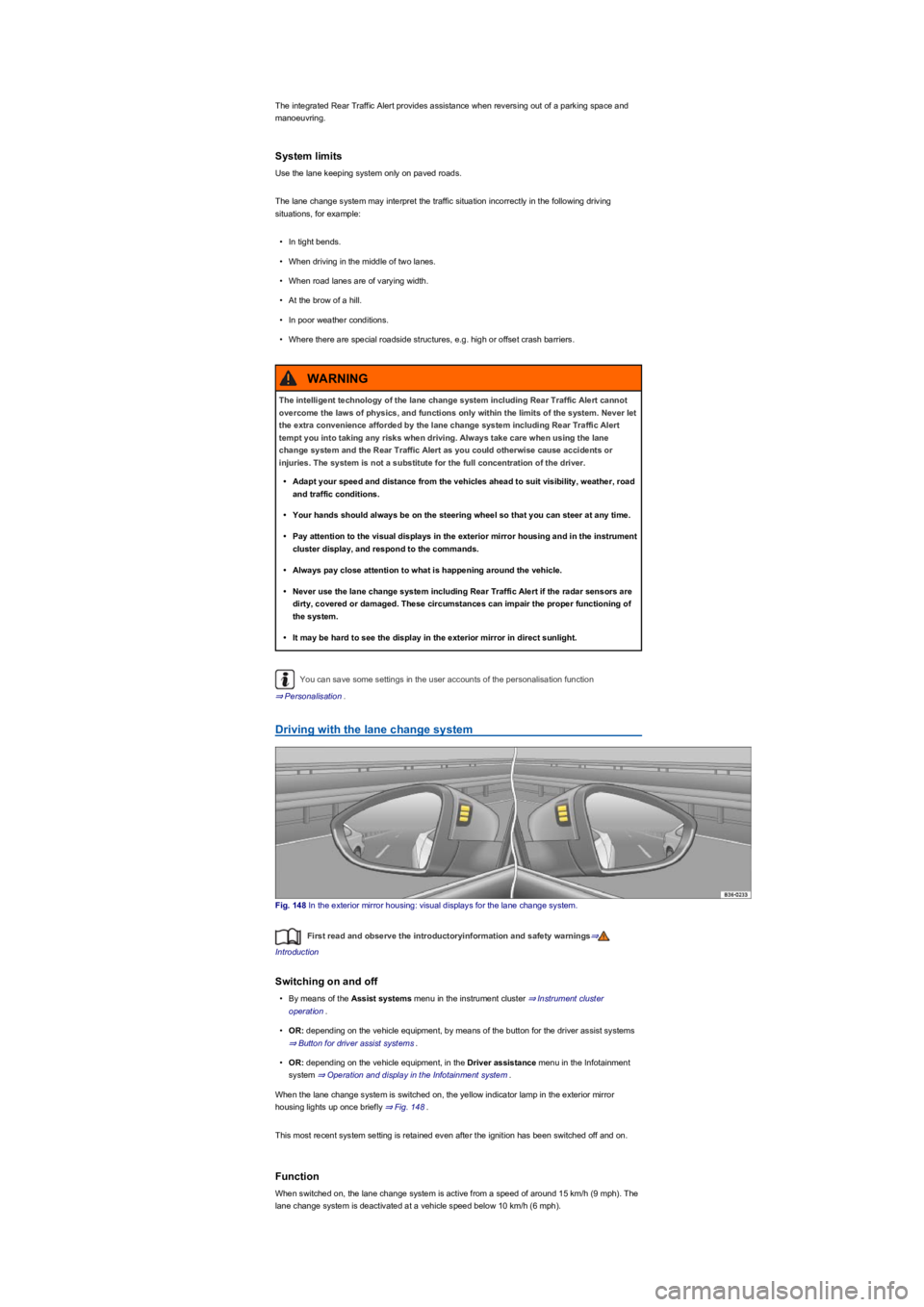
The integrated Rear Traffic Alert provides assistance when reversing out of a parking space and
manoeuvring.
System limits
Use the lane keeping system only on paved roads.
The lane change system may interpret the traffic situation incorrectly in the following driving
situations, for example:
•In tight bends.
•When driving in the middle of two lanes.
•When road lanes are of varying width.
•At the brow of a hill.
•In poor weather conditions.
•Where there are special roadside structures, e.g. high or offset crash barriers.
You can save some settings in the user accounts of the personalisation function
⇒ Personalisation.
Driving with the lane change system
Fig. 148 In the exterior mirror housing: visual displays for the lane change system.
First read and observe the introductoryinformation and safety warnings⇒
Introduction
Switching on and off
•By means of the Assist systems menu in the instrument cluster ⇒ Instrument cluster
operation.
•OR: depending on the vehicle equipment, by means of the button for the driver assist systems
⇒ Button for driver assist systems.
•OR: depending on the vehicle equipment, in the Driver assistance menu in the Infotainment
system ⇒ Operation and display in the Infotainment system.
When the lane change system is switched on, the yellow indicator lamp in the exterior mirror
housing lights up once briefly ⇒ Fig. 148.
This most recent system setting is retained even after the ignition has been switched off and on.
Function
When switched on, the lane change system is active from a speed of around 15 km/h (9 mph). The
lane change system is deactivated at a vehicle speed below 10 km/h (6 mph).
The intelligent technology of the lane change system including Rear Traffic Alert cannot
overcome the laws of physics, and functions only within the limits of the system. Never let
the extra convenience afforded by the lane change system including Rear Traffic Alert
tempt you into taking any risks when driving. Always take care when using the lane
change system and the Rear Traffic Alert as you could otherwise cause accidents or
injuries. The system is not a substitute for the full concentration of the driver.
•Adapt your speed and distance from the vehicles ahead to suit visibility, weather, road
and traffic conditions.
•Your hands should always be on the steering wheel so that you can steer at any time.
•Pay attention to the visual displays in the exterior mirror housing and in the instrument
cluster display, and respond to the commands.
•Always pay close attention to what is happening around the vehicle.
•Never use the lane change system including Rear Traffic Alert if the radar sensors are
dirty, covered or damaged. These circumstances can impair the proper functioning of
the system.
•It may be hard to see the display in the exterior mirror in direct sunlight.
WARNING
Page 188 of 341
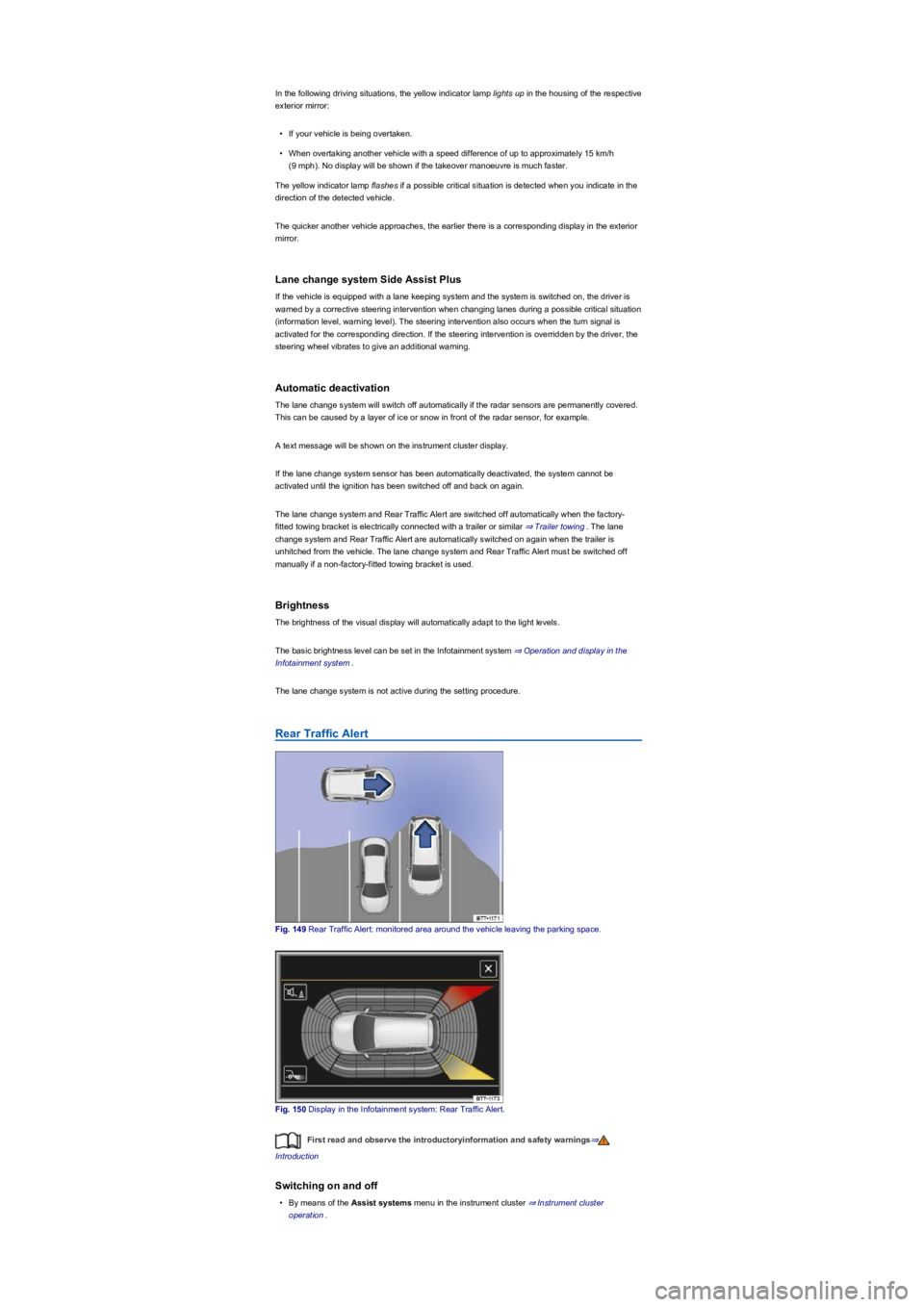
In the following driving situations, the yellow indicator lamp lights up in the housing of the respective
exterior mirror:
•If your vehicle is being overtaken.
•When overtaking another vehicle with a speed difference of up to approximately 15 km/h
(9 mph). No display will be shown if the takeover manoeuvre is much faster.
The yellow indicator lamp flashes if a possible critical situation is detected when you indicate in the
direction of the detected vehicle.
The quicker another vehicle approaches, the earlier there is a corresponding display in the exterior
mirror.
Lane change system Side Assist Plus
If the vehicle is equipped with a lane keeping system and the system is switched on, the driver is
warned by a corrective steering intervention when changing lanes during a possible critical situation
(information level, warning level). The steering intervention also occurs when the turn signal is
activated for the corresponding direction. If the steering intervention is overridden by the driver, the
steering wheel vibrates to give an additional warning.
Automatic deactivation
The lane change system will switch off automatically if the radar sensors are permanently covered.
This can be caused by a layer of ice or snow in front of the radar sensor, for example.
A text message will be shown on the instrument cluster display.
If the lane change system sensor has been automatically deactivated, the system cannot be
activated until the ignition has been switched off and back on again.
The lane change system and Rear Traffic Alert are switched off automatically when the factory-
fitted towing bracket is electrically connected with a trailer or similar ⇒ Trailer towing. The lane
change system and Rear Traffic Alert are automatically switched on again when the trailer is
unhitched from the vehicle. The lane change system and Rear Traffic Alert must be switched off
manually if a non-factory-fitted towing bracket is used.
Brightness
The brightness of the visual display will automatically adapt to the light levels.
The basic brightness level can be set in the Infotainment system ⇒ Operation and display in the
Infotainment system.
The lane change system is not active during the setting procedure.
Rear Traffic Alert
Fig. 149 Rear Traffic Alert: monitored area around the vehicle leaving the parking space.
Fig. 150 Display in the Infotainment system: Rear Traffic Alert.
First read and observe the introductoryinformation and safety warnings⇒
Introduction
Switching on and off
•By means of the Assist systems menu in the instrument cluster ⇒ Instrument cluster
operation.
Page 189 of 341
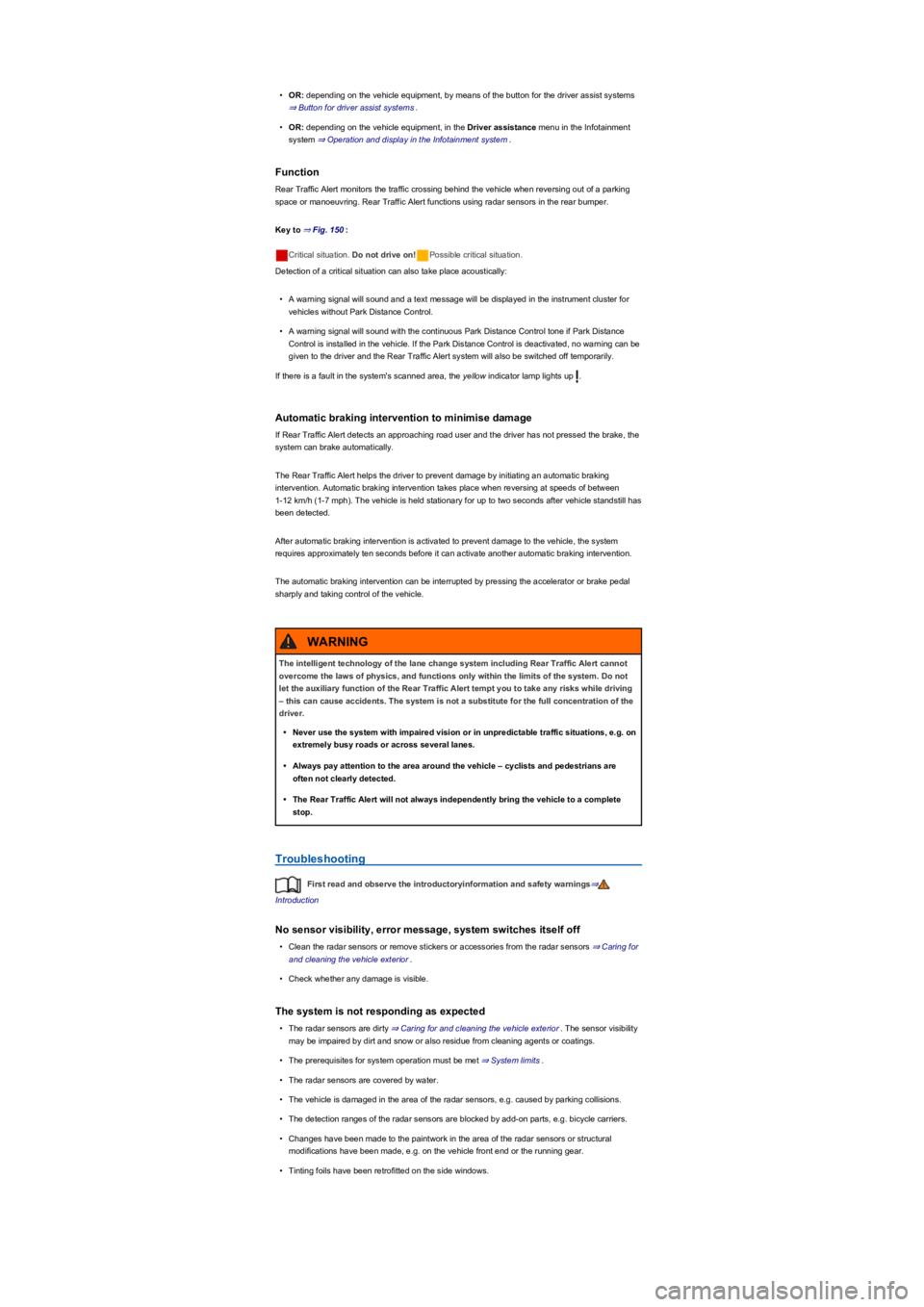
•OR: depending on the vehicle equipment, by means of the button for the driver assist systems
⇒ Button for driver assist systems.
•OR: depending on the vehicle equipment, in the Driver assistance menu in the Infotainment
system ⇒ Operation and display in the Infotainment system.
Function
Rear Traffic Alert monitors the traffic crossing behind the vehicle when reversing out of a parking
space or manoeuvring. Rear Traffic Alert functions using radar sensors in the rear bumper.
Key to ⇒ Fig. 150:
Critical situation. Do not drive on!Possible critical situation.
Detection of a critical situation can also take place acoustically:
•A warning signal will sound and a text message will be displayed in the instrument cluster for
vehicles without Park Distance Control.
•A warning signal will sound with the continuous Park Distance Control tone if Park Distance
Control is installed in the vehicle. If the Park Distance Control is deactivated, no warning can be
given to the driver and the Rear Traffic Alert system will also be switched off temporarily.
If there is a fault in the system's scanned area, the yellow indicator lamp lights up .
Automatic braking intervention to minimise damage
If Rear Traffic Alert detects an approaching road user and the driver has not pressed the brake, the
system can brake automatically.
The Rear Traffic Alert helps the driver to prevent damage by initiating an automatic braking
intervention. Automatic braking intervention takes place when reversing at speeds of between
1-12 km/h (1-7 mph). The vehicle is held stationary for up to two seconds after vehicle standstill has
been detected.
After automatic braking intervention is activated to prevent damage to the vehicle, the system
requires approximately ten seconds before it can activate another automatic braking intervention.
The automatic braking intervention can be interrupted by pressing the accelerator or brake pedal
sharply and taking control of the vehicle.
Troubleshooting
First read and observe the introductoryinformation and safety warnings⇒
Introduction
No sensor visibility, error message, system switches itself off
•Clean the radar sensors or remove stickers or accessories from the radar sensors ⇒ Caring for
and cleaning the vehicle exterior.
•Check whether any damage is visible.
The system is not responding as expected
•The radar sensors are dirty ⇒ Caring for and cleaning the vehicle exterior. The sensor visibility
may be impaired by dirt and snow or also residue from cleaning agents or coatings.
•The prerequisites for system operation must be met ⇒ System limits.
•The radar sensors are covered by water.
•The vehicle is damaged in the area of the radar sensors, e.g. caused by parking collisions.
•The detection ranges of the radar sensors are blocked by add-on parts, e.g. bicycle carriers.
•Changes have been made to the paintwork in the area of the radar sensors or structural
modifications have been made, e.g. on the vehicle front end or the running gear.
•Tinting foils have been retrofitted on the side windows.
The intelligent technology of the lane change system including Rear Traffic Alert cannot
overcome the laws of physics, and functions only within the limits of the system. Do not
let the auxiliary function of the Rear Traffic Alert tempt you to take any risks while driving
– this can cause accidents. The system is not a substitute for the full concentration of the
driver.
•Never use the system with impaired vision or in unpredictable traffic situations, e.g. on
extremely busy roads or across several lanes.
•Always pay attention to the area around the vehicle – cyclists and pedestrians are
often not clearly detected.
•The Rear Traffic Alert will not always independently bring the vehicle to a complete
stop.
WARNING
Page 190 of 341
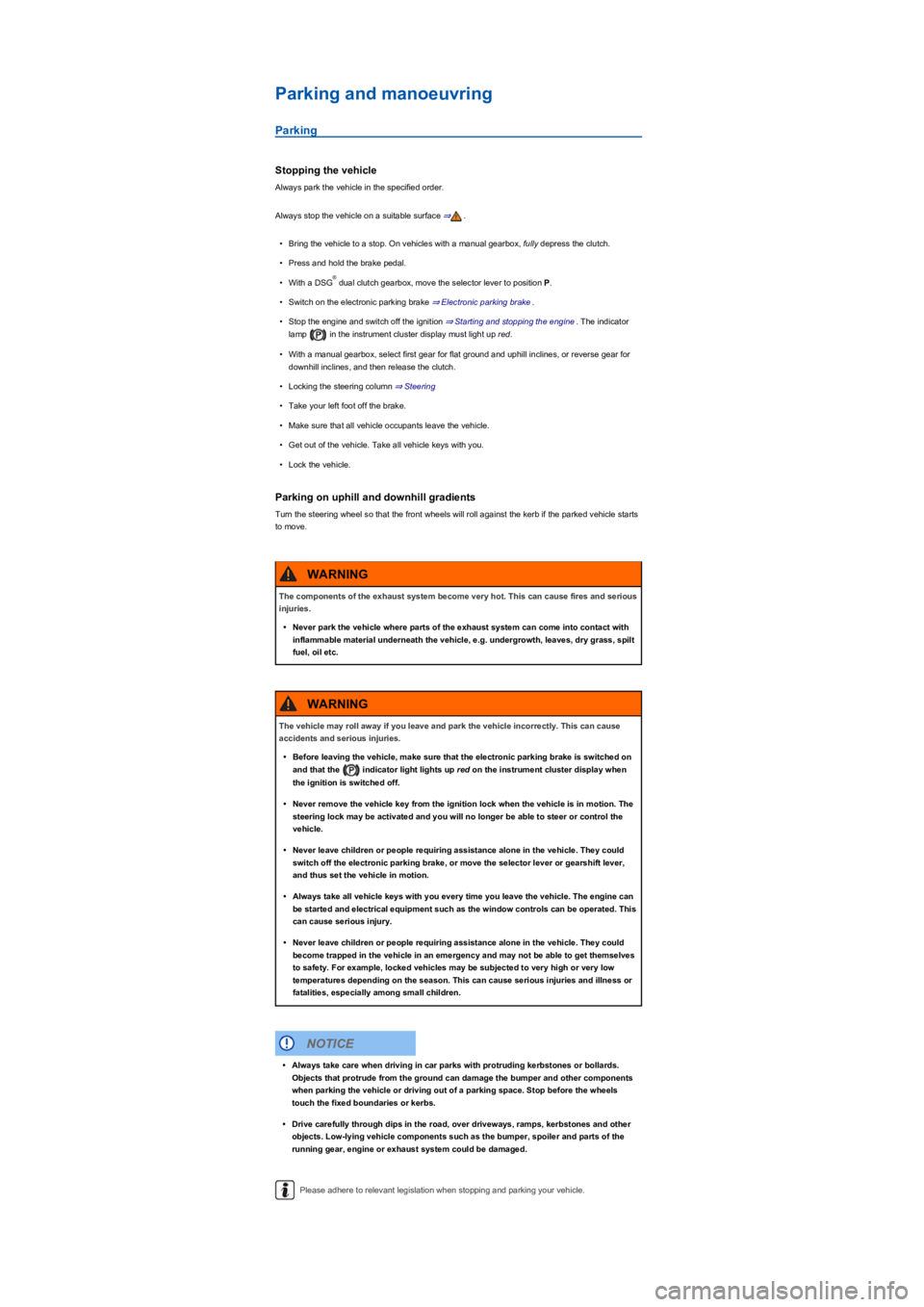
Parking and manoeuvring
Parking
Stopping the vehicle
Always park the vehicle in the specified order.
Always stop the vehicle on a suitable surface ⇒.
•Bring the vehicle to a stop. On vehicles with a manual gearbox, fully depress the clutch.
•Press and hold the brake pedal.
•With a DSG dual clutch gearbox, move the selector lever to position P.
•Switch on the electronic parking brake ⇒ Electronic parking brake.
•Stop the engine and switch off the ignition ⇒ Starting and stopping the engine. The indicator
lamp in the instrument cluster display must light up red.
•With a manual gearbox, select first gear for flat ground and uphill inclines, or reverse gear for
downhill inclines, and then release the clutch.
•Locking the steering column ⇒ Steering
•Take your left foot off the brake.
•Make sure that all vehicle occupants leave the vehicle.
•Get out of the vehicle. Take all vehicle keys with you.
•Lock the vehicle.
Parking on uphill and downhill gradients
Turn the steering wheel so that the front wheels will roll against the kerb if the parked vehicle starts
to move.
Please adhere to relevant legislation when stopping and parking your vehicle.
®
The components of the exhaust system become very hot. This can cause fires and serious
injuries.
•Never park the vehicle where parts of the exhaust system can come into contact with
inflammable material underneath the vehicle, e.g. undergrowth, leaves, dry grass, spilt
fuel, oil etc.
WARNING
The vehicle may roll away if you leave and park the vehicle incorrectly. This can cause
accidents and serious injuries.
•Before leaving the vehicle, make sure that the electronic parking brake is switched on
and that the indicator light lights up red on the instrument cluster display when
the ignition is switched off.
•Never remove the vehicle key from the ignition lock when the vehicle is in motion. The
steering lock may be activated and you will no longer be able to steer or control the
vehicle.
•Never leave children or people requiring assistance alone in the vehicle. They could
switch off the electronic parking brake, or move the selector lever or gearshift lever,
and thus set the vehicle in motion.
•Always take all vehicle keys with you every time you leave the vehicle. The engine can
be started and electrical equipment such as the window controls can be operated. This
can cause serious injury.
•Never leave children or people requiring assistance alone in the vehicle. They could
become trapped in the vehicle in an emergency and may not be able to get themselves
to safety. For example, locked vehicles may be subjected to very high or very low
temperatures depending on the season. This can cause serious injuries and illness or
fatalities, especially among small children.
WARNING
•Always take care when driving in car parks with protruding kerbstones or bollards.
Objects that protrude from the ground can damage the bumper and other components
when parking the vehicle or driving out of a parking space. Stop before the wheels
touch the fixed boundaries or kerbs.
•Drive carefully through dips in the road, over driveways, ramps, kerbstones and other
objects. Low-lying vehicle components such as the bumper, spoiler and parts of the
running gear, engine or exhaust system could be damaged.
NOTICE
Page 193 of 341
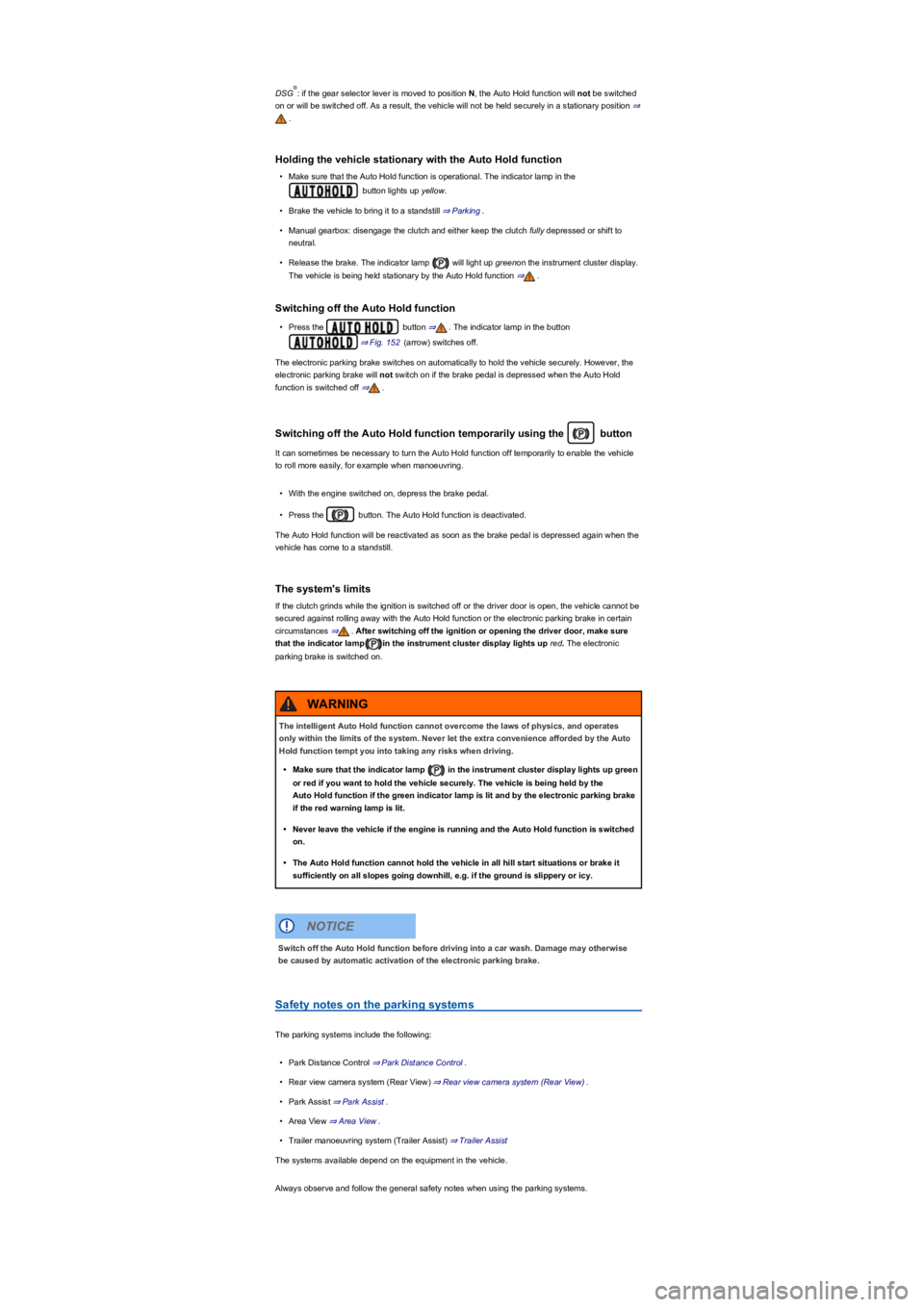
DSG: if the gear selector lever is moved to position N, the Auto Hold function will not be switched
on or will be switched off. As a result, the vehicle will not be held securely in a stationary position ⇒
.
Holding the vehicle stationary with the Auto Hold function
•Make sure that the Auto Hold function is operational. The indicator lamp in the
button lights up yellow.
•Brake the vehicle to bring it to a standstill ⇒ Parking.
•Manual gearbox: disengage the clutch and either keep the clutch fully depressed or shift to
neutral.
•Release the brake. The indicator lamp will light up greenon the instrument cluster display.
The vehicle is being held stationary by the Auto Hold function ⇒.
Switching off the Auto Hold function
•Press the button ⇒. The indicator lamp in the button
⇒ Fig. 152 (arrow) switches off.
The electronic parking brake switches on automatically to hold the vehicle securely. However, the
electronic parking brake will not switch on if the brake pedal is depressed when the Auto Hold
function is switched off ⇒.
Switching off the Auto Hold function temporarily using the button
It can sometimes be necessary to turn the Auto Hold function off temporarily to enable the vehicle
to roll more easily, for example when manoeuvring.
•With the engine switched on, depress the brake pedal.
•Press the button. The Auto Hold function is deactivated.
The Auto Hold function will be reactivated as soon as the brake pedal is depressed again when the
vehicle has come to a standstill.
The system's limits
If the clutch grinds while the ignition is switched off or the driver door is open, the vehicle cannot be
secured against rolling away with the Auto Hold function or the electronic parking brake in certain
circumstances ⇒. After switching off the ignition or opening the driver door, make sure
that the indicator lampin the instrument cluster display lights up red. The electronic
parking brake is switched on.
Safety notes on the parking systems
The parking systems include the following:
•Park Distance Control ⇒ Park Distance Control.
•Rear view camera system (Rear View) ⇒ Rear view camera system (Rear View).
•Park Assist ⇒ Park Assist.
•Area View ⇒ Area View.
•Trailer manoeuvring system (Trailer Assist) ⇒ Trailer Assist
The systems available depend on the equipment in the vehicle.
Always observe and follow the general safety notes when using the parking systems.
®
The intelligent Auto Hold function cannot overcome the laws of physics, and operates
only within the limits of the system. Never let the extra convenience afforded by the Auto
Hold function tempt you into taking any risks when driving.
•Make sure that the indicator lamp in the instrument cluster display lights up green
or red if you want to hold the vehicle securely. The vehicle is being held by the
Auto Hold function if the green indicator lamp is lit and by the electronic parking brake
if the red warning lamp is lit.
•Never leave the vehicle if the engine is running and the Auto Hold function is switched
on.
•The Auto Hold function cannot hold the vehicle in all hill start situations or brake it
sufficiently on all slopes going downhill, e.g. if the ground is slippery or icy.
WARNING
Switch off the Auto Hold function before driving into a car wash. Damage may otherwise
be caused by automatic activation of the electronic parking brake.
NOTICE